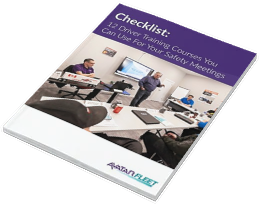![]()
This is a continuation of our blog series on Safety Leadership. In the first blog, we defined safety as “Freedom from risk.” And, based on that definition, we can never truly be safe. The best we can hope for is to manage risk. In this article, we’ll present Avatar’s risk management model. We’ll explain why it’s so important and give a few examples of how to use it to manage risk in your operation.
Managing Risk: Impact and Effort
The risk management model consists of five strategies that you can use to manage risk. They’re organized to provide the greatest impact with the least amount of effort. The strategies are visually represented as a pyramid.
Avoid Risk
The first strategy to manage risk is to AVOID RISK. It’s that simple. When you were a little child, your mom said, “if you don’t want to get burned, don’t play with matches.” She was right. If you don’t want to be eaten by a shark, don’t swim in the ocean. If you don’t want to die in a skydiving accident, don’t jump out of airplanes. The fastest, easiest and most effective way to manage risk is to AVOID RISK.
Let’s look at a couple of examples that apply to your operation. You can avoid certain routes that pose greater risk. Or, you can avoid hiring drivers who are willing to accept too much risk. But you can’t always avoid risk. If you’re in the transportation business and put vehicles out on the road every day, you face a lot of risk that you can’t avoid. That brings us to our second strategy.
Eliminate Risk
The next strategy is to ELIMINATE RISK. As we look across the enterprise, we can identify things that pose risk. Sometimes, we can eliminate them. For example, maybe you have underground storage tanks to fuel your vehicles. They pose a risk of leaking and causing an environmental hazard. You can eliminate that risk by removing the tanks and going to the local station to buy your fuel.
Another way that you can ELIMINATE RISK is to terminate a driver who has had multiple accidents. You can also ELIMINATE unsafe conditions such as broken ladders, potholes in the yard and old equipment.
Engineering Controls
Sometimes we can’t AVOID the risk and we can’t ELIMINATE the risk. That’s when we turn to the third strategy, ENGINEERING CONTROLS. Engineering controls attempt to manage our risk by mechanical means or altered processes. Classic examples include the safety belt, antilock brakes, airbags, proximity devices, anti-rollover devices and backing cameras. These controls should make us safer, but unfortunately, they often fall short of our expectations.
Every living human being has a certain level of risk he or she is willing to tolerate. It’s called risk homeostasis. Countless scientific studies have proven time and again that the more protection I provide you, the more risk you’ll take. It seems counter-intuitive, however children in karate class who’ve been given protective gear and padding have more injuries than those who don’t have any protective gear. NFL players, who are virtually encased in an exoskeleton, have more injuries than Australian rugby players who wear no protection at all. When antilock brakes were installed on London’s taxi cabs, following distance collisions increased by 35%. Why? Because subconsciously our brain thinks that if we have greater protection, we no longer need to be as vigilant.
Human Factors
Which brings us to the fourth strategy: HUMAN FACTORS. This is primarily where AvatarFleet focuses its energy. We design processes that influence human behavior. The goal is to reduce or eliminate unsafe behaviors and by doing so, reduce or eliminate accidents. When it comes to HUMAN FACTORS, what can we do? We can educate our employees so that they understand risk and what to avoid. We can train them how to behave more safely and how to avoid risks. We can motivate them through rewards programs, some as simple as giving them a little recognition. We can consistently communicate safety messages to maintain awareness about the risks they face.
Transfer Risk
Each of the four strategies thus far provide value and help you manage risk. However, if you couldn’t AVOID the risk, ELIMINATE the risk, ENGINEER the risk or alter your employees’ behaviors (HUMAN FACTORS), you still have to do something. And that brings us to the fifth strategy for managing risk which is to transfer the risk to others. You can buy insurance. Insurance is nothing more than pooling your resources with others who face similar risks, knowing that one day one of you will face a major loss. The combined resources of the group provide funding to pay for that loss.
Buying insurance is the least effective and most expensive way to manage risk.
So, there you have AvatarFleet’s risk management model. AVOID, ELIMINATE, ENGINEER, HUMAN FACTORS and TRANSFER. The risk management model is an effective tool for managing risk in your operation. Apply the model and always begin at the bottom. Work your way up as needed and you will most cost-effectively and most efficiently manage risk and achieve better safety results.
Sign up for our newsletter
Get the latest articles on all things transportation delivered straight to your inbox.
Schedule a live demo

